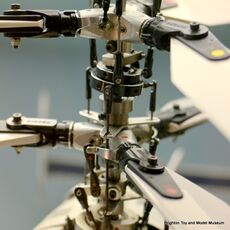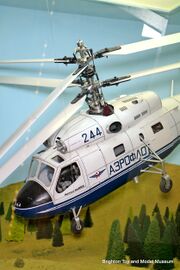Kamov Ka-25 radio controlled model helicopter (Gordon Bowd)
| Display Area |
|---|
 |
| 2 - Kamov Ka-25 helicopter (RC model) Arch Two |
| –– 01 02 03 04 05 06 07 08 09
10 11 12 13 14 15 16 17 18 19 20 21 22 23 24 25 26 27 28 29 30 31 32 33 34 35 36 37 38 39 40 41 42 43 44 45 46 47 48 49 50 51 52 53 54 55 –– 57 58 –– –– 61 62 63 64 65 66 67 –– –– –– 71 72 73 74 –– 76 77 78 79 80 81 82 83 84 85 86 –– –– –– |
| Star Exhibit |
|---|
Kamov Ka-25 radio controlled model helicopter (Gordon Bowd) |
 |
| location: |
| Arch Two , Area 2 Kamov Ka-25 helicopter (RC model) |
The large radio-controlled model of a Kamov Ka-25K helicopter with two contrarotating sets of rotors is to the left of the entrance to Arch Two of the Museum. Its custom-built display cabinet is designed to look like a Russian airport control tower, and holds the model in an "action" pose, above small-scale background scenery.
The model was built by Gordon Bowd, and there's a photograph on the exhibit of the helicopter being flown by its builder.
The Ka-25
The Ka-25 model is an exceptional radio-controlled helicopter due to the sophistication of the Ka-25's rotor design. Most Western helicopters have a single rotor that rotates in one direction, giving the craft a natural tendency to counterrotate, and rotate the other way. To keep the 'copter's nose pointing forward it's traditional to give the helicopter a separate vertical tail rotor at the end of a long tail assembly, whose purpose is to produce sideways thrust to counteract the rotation problem. Making the tail longer lets the tail rotor exert more rotational leverage on the aircraft but also increases the helicopter's overall length (which isn't ideal when a large number of helicopters need to work from a confined space such as an aircraft carrier). The extended tail and its driveshaft provide additional vulnerabilities for a military helicopter, increase the size of the helicopter's critical "bullseye" region when under fire, and are are difficult to "harden" against attack without adding excessive weight.
Kamov specialise in more compact helicopter designs that use two engines and two main rotors that spin in opposite directions. One rotor is directly above the other ("coaxial rotors"), a trick that's achieved by fitting one rotor shaft inside the other. This design removes the need for a tail rotor (and a tail), and the lack of complicated tail airflow considerations then makes it easier to design more radical helicopter shapes that can incorporate more "airplane-like" features like rearward-aimed thrust nozzles. Rotor blade length is one of the limiting factors for a helicopter's theoretical maximum speed, and with two rotors, the Kamov designs can use shorter blades and achieve higher speeds.
The compact dual-rotor design also allowed more creativity when it came to adding features and building in robustness. As two-engine designs, the Kamov range could survive a total loss of one engine, and the lack of a vulnerable tail rotor extension and gearing allowed critical systems to be concentrated in the centre of the aircraft where they were more efficiently protected by armour and shielded by less critical systems, as in the Ka-50. Other radical features included in some of the Kamov models include detonating rotor assemblies that permit rocket-propelled ejector seats.
Article: Model Helicopter World
The model was featured in the January 2001 issue of Model Helicopter World, who produced a four-page article on the machine, with detailed photographs and an interview with Gordon Bowd on the model helicopter's construction and the unique challenges that it represented. A laminated copy of the article is displayed alongside the model.




